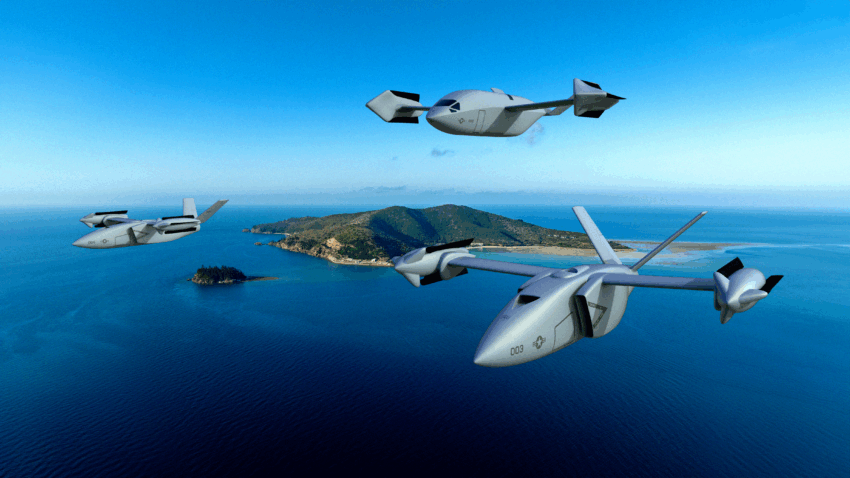An artist’s rendering of Bell’s stop/fold rotor aircraft design, which the company is pitching for the SPRINT program. (Bell photo)
WASHINGTON — The Pentagon’s Defense Advanced Research Projects Agency (DARPA) has selected Bell Textron to manufacture a high-speed, runway-independent experimental aircraft, axing competitor Aurora Flight Sciences.
In a press release today, Bell said it has been selected for Phase 2 of DARPA’s Speed and Runway Independent Technologies (SPRINT) program, greenlighting the company to proceed with the “design, construction, ground testing and certification” of the firm’s X-plane candidate, according to the release. A third phase is planned for flight testing.
A spokesperson for DARPA confirmed to Breaking Defense today that Bell was the sole company picked for SPRINT’s second phase, which the agency expects will culminate in a completed demonstrator in 2027 that would then enter flight testing in 2028. DARPA is requesting $55.2 million for the program for fiscal 2026, according to budget documents [PDF].
“Bell is honored to have been selected for the next phase of DARPA’s SPRINT program and is excited to demonstrate a brand-new aircraft with the first-ever stop/fold technology,” Jason Hurst, Bell’s executive vice president for engineering, said in the company’s release. “This is an achievement we’ve been working towards for over 10 years, as we’ve leveraged our nearly 90-year history of X-plane development to bring new technology to our warfighters.”
The SPRINT effort, which is jointly run by DARPA and US Special Operations Command, envisions an X-plane that can vertically take off and land, fly at speeds from 400 to 450 knots (over 500 mph) and “hover in austere environments from unprepared surfaces,” according to DARPA. The agency has said it hopes to validate the underlying tech that could later be adapted into aircraft of various sizes and designs.
The program’s first phase featured competitors Northrop Grumman and Piasecki Aircraft Corp., along with Aurora and Bell. The latter two companies were picked to advance in the program’s Phase 1B stage last year.
Aurora, a subsidiary of Boeing, said in a statement to Breaking Defense today that the company “designed a high lift, low drag fan-in-wing X-plane to enable a transformational combination of aircraft speed and runway independence. Testing conducted during Phase 1 of the SPRINT program validated the feasibility of the design and analytical estimates of aircraft performance.” The company added that it “is proud of the advancements we made through SPRINT, and we are looking forward to applying fan-in-wing technology to future high-speed, vertical lift programs.”
As part of risk reduction efforts for SPRINT, Bell says it has demonstrated “folding rotor, integrated propulsion, and flight control technologies at Holloman Air Force Base” and conducted “wind tunnel testing at the National Institute for Aviation Research at Wichita State University.” Bell’s X-plane “stop/fold” tech features a tilting rotor used for hovering as well as vertical takeoff and landing, which can then be stowed to reduce drag. Jet engines would then provide forward thrust to achieve higher speeds, according to The Warzone.
The company has previously advertised its X-plane bid as an uncrewed system capable of sea-based missions, hoping to serve as an asset for the US military in austere environments like the Indo-Pacific where runways are sparse.
Besides the SPRINT program, Bell is also working on other next-gen aircraft designs, such as the Army’s V-280 Valor aircraft that the company was picked to build for the Future Long Range Assault Aircraft program. The Army is now working to accelerate FLRAA.
Click this link for the original source of this article.
Author: Michael Marrow
This content is courtesy of, and owned and copyrighted by, https://breakingdefense.com and its author. This content is made available by use of the public RSS feed offered by the host site and is used for educational purposes only. If you are the author or represent the host site and would like this content removed now and in the future, please contact USSANews.com using the email address in the Contact page found in the website menu.








